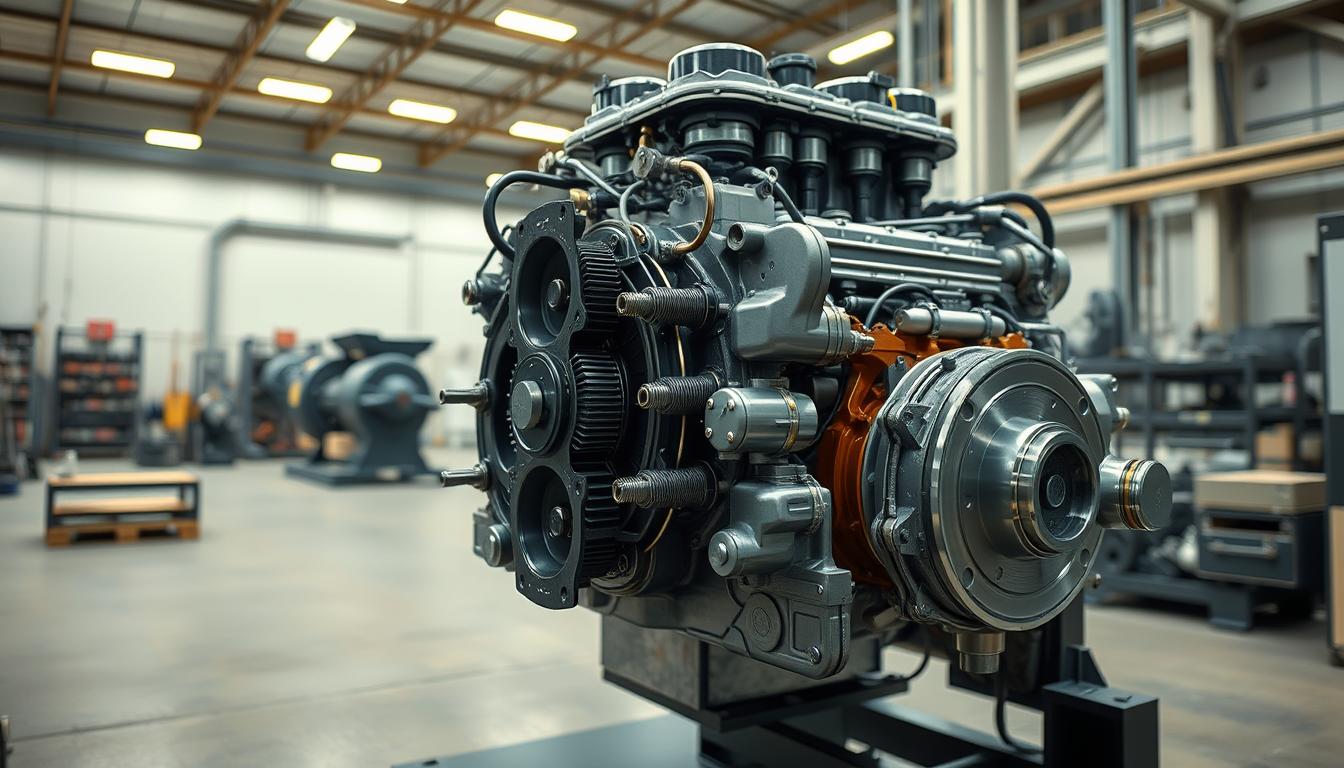Exploring the dual fuel diesel engine, I see its big role in today’s cars and factories. It uses diesel and other fuels, making it very efficient and flexible. This engine is great for many uses because it works well with different fuels.
By using both fuels, it performs better and helps the environment. I’ll look into what makes these engines special, their advantages, and their future. They show our move towards cleaner energy.
What is a Dual Fuel Diesel Engine?
A dual fuel diesel engine is a new step in engine technology. It’s made to run on diesel but can also use natural gas or biogas. This lets the engine switch between fuels, improving efficiency and cutting down on emissions.
This engine has special controls that watch over the fuel injection. It makes sure the engine works well with any fuel. Sensors find the best mix of diesel and alternative fuel, making the engine perform better and be kinder to the environment.
Using alternative fuels like natural gas can help the environment. They produce fewer greenhouse gases than regular diesel. Knowing this is key as we look at how dual fuel diesel engines are used today.
Benefits of a Dual Fuel Diesel Engine:
Dual fuel diesel engines offer many advantages. One major benefit is the economic savings. They can run on cheaper alternative fuels instead of traditional diesel. This cuts down on fuel costs and boosts operational efficiency.
From an environmental standpoint, these engines are a win. They use cleaner fuels, which means less harmful emissions. This helps reduce the carbon footprint, making them a key choice for businesses looking to be green.
Another plus is the operational flexibility. I can easily switch between fuels based on what’s available. This keeps my operations running smoothly, meeting the needs of the industry.
Components of a Dual Fuel Diesel Engine:
When I think about a dual fuel diesel engine, I focus on its special parts. Fuel injectors are key, designed for different fuels. This lets the engine easily switch between diesel and other fuels, improving performance.
Control systems are also vital. They manage the fuel mix for efficient burning and better fuel use. The engine management system adjusts settings to keep performance high and emissions low.
Adding dual fuel tech to diesel engines requires changes. Knowing these parts helps improve how well the engine works and lasts longer. This makes dual fuel systems great for today’s engines.
Diesel Engine Performance with Dual Fuel Systems:
I find the performance of diesel engines with dual fuel systems fascinating. These setups offer big advantages, like better engine performance and fuel efficiency. When comparing dual fuel diesel engines to regular diesel motors, I see big gains in power and torque.
Performance tests show that thermal efficiency goes up in dual fuel systems. Fuel use drops, making the engine more efficient. This allows for using different fuels with diesel, making the engine more versatile and efficient.
In real-world use, dual fuel diesel engines show their worth. Many industries are switching to these engines for better performance and lower costs. This change shows how diesel engines are viewed in terms of the environment and efficiency. Tests consistently show the benefits of dual fuel systems, making them a great choice for modern engines.
Applications of Dual Fuel Diesel Engines:
Dual fuel diesel engines are used in many areas. In transportation, they help logistics companies save money. They can change fuels when prices change, which cuts costs.
Marine industries also use these engines. Ships need to meet strict pollution rules. Dual fuel engines help them do this in a green way.
These engines are also key in power generation. They work well in places far from power plants. This makes them perfect for areas without easy access to energy.
The wide use of dual fuel diesel engines shows their value. They help make energy use better and cleaner in many fields.
Challenges and Considerations:
Exploring dual fuel diesel engines, I face several challenges. One major issue is reliability. Mixing different fuels can cause unexpected problems, affecting engine performance. Poor fuel quality can lead to bad combustion and engine troubles.
Maintenance is another big challenge. Dual fuel systems need more checks and tweaks because of the different fuels. This means more time and money for upkeep. Regular maintenance is key to keeping the engine running well for longer.
Regulations also play a big role. In some places, there’s no support for alternative fuels, making things hard. It’s important to know local rules on fuel use and emissions. This knowledge helps overcome the hurdles and enjoy the benefits of dual fuel engines.
The Future of Dual Fuel Diesel Engines:
Looking ahead, innovation is key for dual fuel diesel engines. The need for sustainability and stricter emissions rules is growing. This means we’ll see big changes in how these engines work.
Renewable fuels are becoming more common, which is good for the planet. This change helps dual fuel diesel engines fit into a greener world. Experts like Bloomberg New Energy Finance and McKinsey & Company agree, seeing a bright future for these engines.
In summary, the future of dual fuel diesel engines looks good. They’re moving towards being more eco-friendly and efficient. Thanks to research from places like the International Energy Agency, I’m hopeful about their future.
